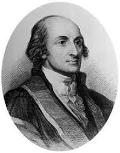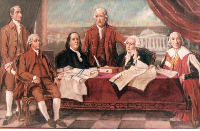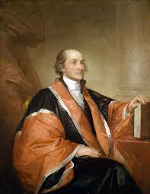John Jay: Statesman, Diplomat, Chief Justice
John Jay was a U.S. Chief Justice, diplomat, governor, and political party leader in colonial America. Jay was born on Dec. 12, 1745, in New York City. He attended French Huguenot Church School and then King's College, found work as a law clerk, and then became a lawyer, beginning practicing in 1768. 
In 1774, Jay married Sarah Livingston, whose father was New York Gov. William Livingston. John and Sarah had six children. Jay represented the people of New York in various capacities through the years. He was a member of the New York Committee of Correspondence, a member of the New York Provincial Congress, a drafter of his state's constitution, and a delegate to the Continental Congress, of which he was president in 1778–1779. Jay, like John Dickinson, opposed independence from Great Britain. Jay did not sign the Declaration of Independence and did not fight in the Revolutionary War. He did support the war effort, however, in a diplomatic capacity. He went to Spain in 1779 to help convince that country to recognize the American colonies as the new country the United States and to get a loan to support the American war effort; Spain agreed to neither request. 
Jay was one of America's representatives at the conference that produced the Treaty of Paris of 1783, which officially ended the Revolutionary War. He was the U.S. Secretary for Foreign Affairs from 1784 to 1789. During this time, he cooperated with Alexander Hamilton and James Madison in writing the Federalist Papers, a series of newspaper articles urging New York residents to ratify the Constitution. He and Hamilton were leaders of the Federalist Party. 
The Judiciary Act of 1789 created the Supreme Court. Washington named Jay as the first Chief Justice of the United States. (He had earlier served as chief justice of the New York Supreme Court.) He served in that capacity until 1794. The Court decided just four cases during his tenure, but Jay established many rules and procedures for the court system. One case that Jay did preside over was Chisholm v. Georgia, in which two men from South Carolina were seeking redress for property that the State of Georgia had impounded after the Revolutionary War. Jay and the Court found that a citizen could sue a state. (This was part of the impetus for the 11th Amendment, which reversed this decision. Against the backdrop of the French Revolution, British troops were still installed in the Old Northwest and British ships were seizing American ships trading with France. Washington sent Jay to London in May 1794 to attempt to avoid conflict between Great Britain and the U.S. The result was the Jay Treaty. The treaty was agreed to in principle in 1794 but took more than a year to work its way through all of the necessary governmental processes. Opposition to the treaty was quite fierce because it left some significant issues unresolved and appeared to many people to be favoring British interests more than American interests; at one point, Jay was burned in effigy. Washington's support for the treaty proved to be the difference, however, as two-thirds of the Senate approved the treaty in November 1796. The treaty's duration was for 10 years. One main issue that Jay pressed but could not get Britain to agree to was a cessation of the impressment of soldiers. Britain continued to seize some ships and force American sailors to join the Royal Navy. This would be a main issue leading to the War of 1812. While Jay was negotiating the treaty that bore his name, voting was taking place in New York for governor. Jay won the election and stepped down from the Supreme Court. (He had run for governor in 1792 and not won.) A very popular governor, he served two terms in all. Among the projects that the state embarked on during his tenure were an expansion of the state's canals, a reorganization of the state judicial system, a reform of the state prison system, and a law to free slaves. Jay helped set up the New York Manumission Society in 1785 and, in 1799, signed an emancipation law that in 1827 resulted in the end of slavery in New York. (He had freed his own slaves in 1798.) Jay retired in 1801, rejecting a plea from newly elected President John Adams to return to the position of Chief Justice. (Oliver Ellsworth had retired.) Jay refused, claiming poor health. One of his last public statements was an 1819 announcement of his opposition to the admittance of Missouri to the Union because he opposed to the slavery. He died on May 17, 1829, at his farm, in Bedford, N.Y. |
|
Social Studies for Kids
copyright 2002–2025
David White





